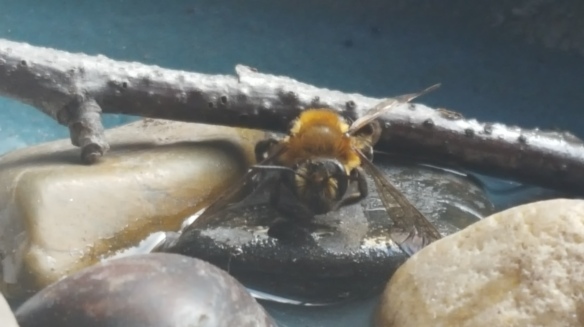Nearly a year ago to the day, I was sitting outside enjoying my last few days of a much-needed vacation and was astounded to see bees flitting about my yard. I guess spring is my preferred vacation time, because this year I found myself in the same situation. Only now, I knew to be on the look out for the mining bees.
I had been looking forward to spring not only because Wisconsin winters always feel too long, but because I was eagerly awaiting the emergence of the mining bees come April or May. After all of my research about last year’s bees, I couldn’t wait to see the life cycle continue and observe the adult bees emerge, knowing that they had hatched from the eggs laid last spring. Perhaps some of them would even be the sons and daughters of Delilah!
Day 1 | Saturday | 22 April 2017
With only a couple days left of my annual spring vacation, I am fortunate enough to have a warm sunny day to relax outside. I glance through my bedroom window that is only inches above the ground and hold back an audible squeal of excitement. The bees are back! I grab my camera, slide into my shoes, and dash out the patio door and stand in awe as my eyes fly eagerly scan the yard. The sun is bright and hot, and the heat stirs the bees beneath the earth, enticing them to emerge, and welcoming them with a warm embrace of light.
It must be one of the first days the bees are out of the ground. At least, one of the first days that both male and female bees are out together. Where I was late to observe the bees last year, this year I think I am lucky enough to see two different mating pairs. I squat in wonder, as I watch within a few inches of each other, a female claw her way slowly out of the earth and a male and female bee twist their bodies together in what I can only assume to be their mating ritual.
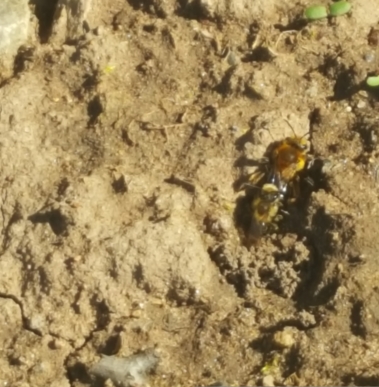
A male and female mining bee presumably mate. Males are light yellow to grey in color and females are dark yellow or orange in color.
They fly about me peacefully, allowing my awkward form to kneel and crouch among them with my phone only inches from their small bodies. Knowing that only the female bees sting, and presuming that they are not too territorial yet without their own homes to defend, they are quite amiable to a human lumbering about.
After I have my fill of picture taking and video recording, I plop myself in a lawn chair with a book and read while they carry on beginning their short adult lives. Amazement and excitement continue to distract me from my book, especially when a bee lands on my leg and rests for a while there, its wings raising and lowering in a slow rhythm, as if it is trying to catch its breath.
Day 2 | Sunday | 23 April 2017
The bees do not come out until the sun has had time to warm the top soil and beat heavily on the area instinct had brought bees to last year (or perhaps the year before). It is a windy spring day and after a failed attempt at a bike ride, I settle into my spot outside my window, balancing on a two-by-four frame nestled in a bed of rocks. It allows me to sit close to the bees and observe their movements while not taking up valuable land. I see less male bees flying around, and of those that I do see, their energy is definitely waning.
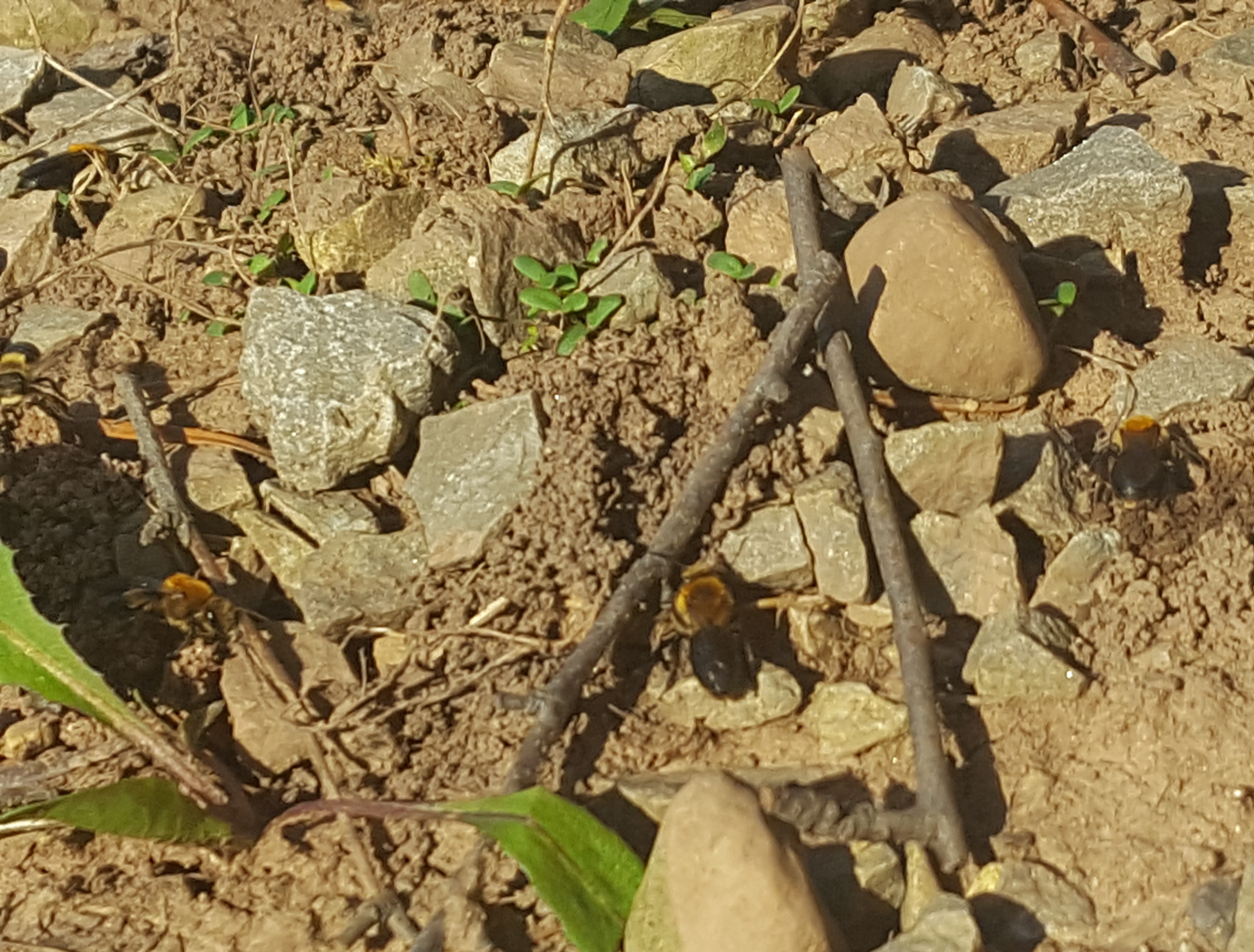
Three female mining bees look for the perfect spot to build their homes.
The females on the other hand are busy testing the sandy soil and preparing to burrow into the ground, creating tunnels for each of the eggs they’ll lay upon a pod of pollen. I wonder what they think of me looming over them, casting a cold shadow over their home openings. At least I serve as a real scarecrow. Many birds watch from the trees, but they stay clear of the insects hovering over the ground as I watch.
Day 4 | Tuesday | 25 April 2017
A few days later, I only have a short amount of time after work to observe how the mining bees are faring. The evening weather is a bit dismal; the clouds send down sprinkles of rain every now and again. I can see though that the female bees have been extremely busy. The ground is littered with dark circles of dirt. The conical mounds around each new bee home are slowly becoming more defined.
 A few bees flying slowly over the ground keep me company as I grill dinner. It is the first day I no longer see any male bees and I wonder if they have perished already or if they are underground with the other females. I realize that I have no idea if the bees go back into the homes from where they came while they search for new places to dig new nests. Do the males dig their own homes? Or do they just emerge to mate and then fly off in search of other mates and food and die far from their original home?
A few bees flying slowly over the ground keep me company as I grill dinner. It is the first day I no longer see any male bees and I wonder if they have perished already or if they are underground with the other females. I realize that I have no idea if the bees go back into the homes from where they came while they search for new places to dig new nests. Do the males dig their own homes? Or do they just emerge to mate and then fly off in search of other mates and food and die far from their original home?
Day 6 | Thursday | 27 April 2017
My evenings are often busy and do not allow me much time to sit outside and observe my bees. It is late in the evening, near sunset when I am able to see what is happening in my yard. I have just finished about a three mile walk in cold and dreary weather, but still I see two bees floating above the ground where the homes have now become more defined. The bees work so quickly, but there are not too many budding plants around. I wonder how far the bees travel to find pollen to pack away underground as a food store for the eggs that will soon be laid . . .
At the time of my writing this, it would be day ten since I saw the bees for the first time this spring. It has been a few days of cold and rain, so I haven’t seen the bees, and the holes to their homes are hard to spot in the flattened and soaked earth. I wonder if the bees take the time during these rainy days to construct their tunnels and wait for the water and future sun to generate a more varied array of flowers to bloom.
From what I have read, mining bees live for four to six weeks once they emerge, so perhaps I shall see them again when the rainy days end. Or, maybe they brave the wetness, knowing they can not wait for a respite from nature if they are to successfully lay their eggs and have enough food for their brood to consume as the egg transforms into a larva and then a pupa and finally into an adult.
There is so much I do not know, and probably never will know about the mining bees. I still am not sure what species lives outside my apartment although it’s a good chance it is Andrena dunningi. But I do not need to know every detail of their lives to still be ecstatic each time I see the bees. I don’t know how to explain what I truly feel watching the bees. It is an odd mixture of happiness and giddiness. Perhaps it is a sense of novelty. Or perhaps it is a feeling of honor to have the chance to observe a native bee species in its natural habitat in a world that continually threatens the lives of such benevolent and beneficial pollinators such as my mining bees.
Watch my video of this year’s mining bees and witness the bees mating and burrowing as detailed in this post.
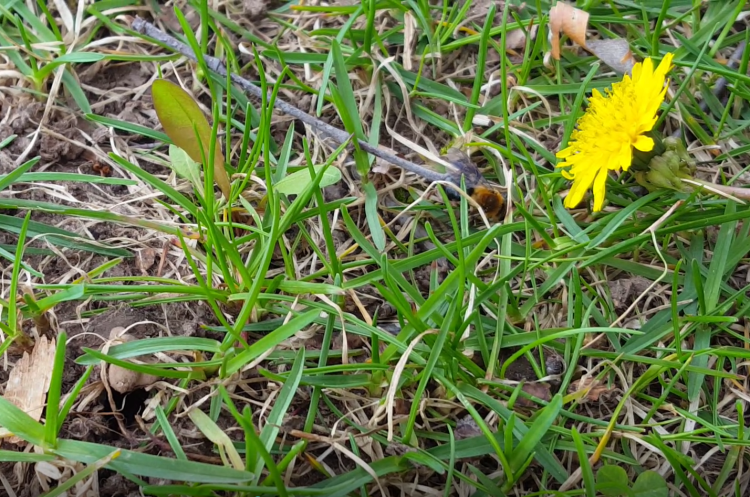
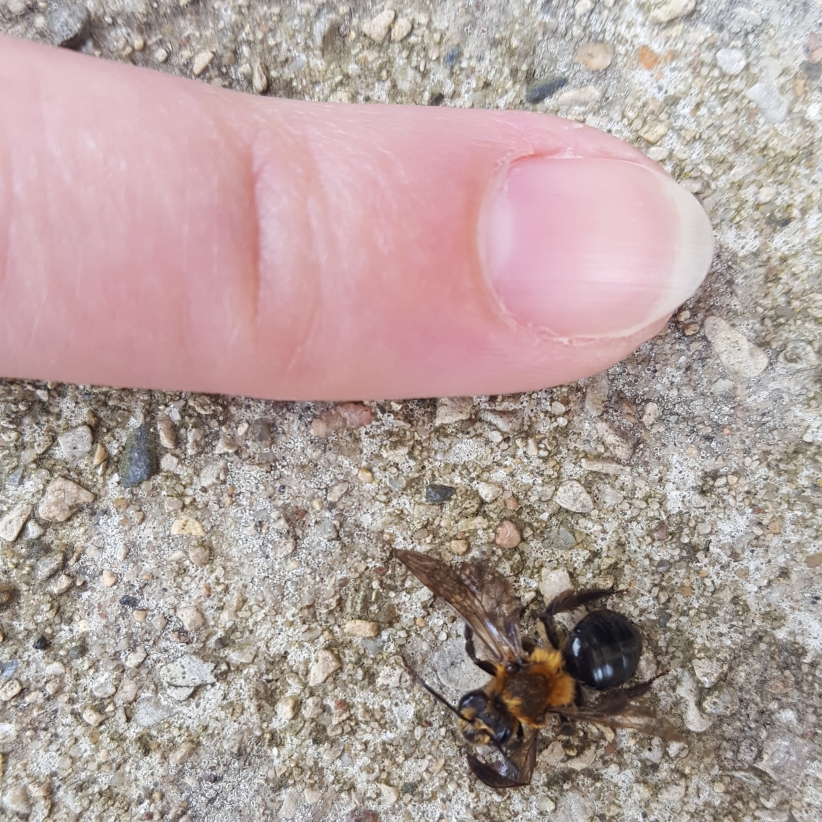
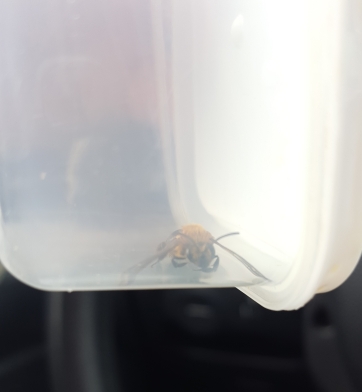
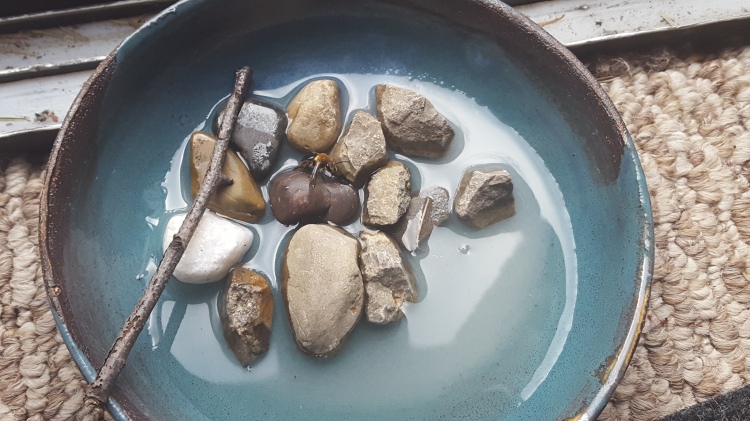
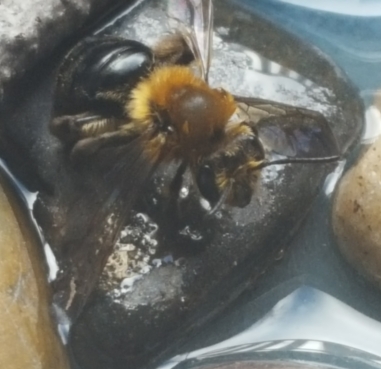 I took a few pictures and videos of Delilah. I considered sending her body to UW-Madison if she died so that they could for sure tell me what kind of bee she was and potentially use my mining bees for some sort of research, or put into a data file of native bee populations in the state of Wisconsin, but I became attached to Delilah. I obviously knew she was just a bee, and besides her broken wing and leg, there was no way for me to tell her apart from any other bee I saw outside. But there was just something so amazing to have the bee there with me in my apartment, now moving more than she had in a day and a half. I couldn’t just give her away to be dissected. I didn’t know for sure if the university would have been willing anyway.
I took a few pictures and videos of Delilah. I considered sending her body to UW-Madison if she died so that they could for sure tell me what kind of bee she was and potentially use my mining bees for some sort of research, or put into a data file of native bee populations in the state of Wisconsin, but I became attached to Delilah. I obviously knew she was just a bee, and besides her broken wing and leg, there was no way for me to tell her apart from any other bee I saw outside. But there was just something so amazing to have the bee there with me in my apartment, now moving more than she had in a day and a half. I couldn’t just give her away to be dissected. I didn’t know for sure if the university would have been willing anyway. I should have tried to save Delilah earlier, so I felt I owed it to her to let her rest in peace, buried beneath the earth she came from days, or only a week before, to begin her short, yet productive, life. And that is what I did come late evening once I noticed that she had not moved in hours. She didn’t stir when I prodded her with a gentle breath of air. She didn’t move to grasp a thin stick I had used to place her in the sugar water dish. I only hoped that she had had enough time to lay her eggs upon a pod of pollen and seal her future offspring safely in the ground. The mining bee’s adult life is short, and it put me at ease to consider that maybe Delilah had done all she had needed and had passed on normally as mining bees do, and that I will have the honor to look on at the new brood come spring, knowing that some of those bees had a very tough and beautiful mother named Delilah.
I should have tried to save Delilah earlier, so I felt I owed it to her to let her rest in peace, buried beneath the earth she came from days, or only a week before, to begin her short, yet productive, life. And that is what I did come late evening once I noticed that she had not moved in hours. She didn’t stir when I prodded her with a gentle breath of air. She didn’t move to grasp a thin stick I had used to place her in the sugar water dish. I only hoped that she had had enough time to lay her eggs upon a pod of pollen and seal her future offspring safely in the ground. The mining bee’s adult life is short, and it put me at ease to consider that maybe Delilah had done all she had needed and had passed on normally as mining bees do, and that I will have the honor to look on at the new brood come spring, knowing that some of those bees had a very tough and beautiful mother named Delilah.